In the past three weeks, teams at Kourou have been loading cargo into ATV – a challenging and complex process that requires extensive planning and preparation.
Now that the final, late-load cargo has been lowered into ATV, the hatch shut, and the fairing fitted over Johannes Kepler, ESA’s Cargo Integration Engineer, Kirsten MacDonell, who is at Kourou overseeing cargo activities, has taken time to send us a detailed, ‘behind-the-scenes’ description of the intense work needed to get the vessel fully loaded.
All aspects of cargo loading on the ground must take into account the priorities of the ISS astronauts and the constraints of zero-gravity operations. Her post is incredibly detailed – perhaps better to print and read on paper – and shows just how much top-notch engineering, effort and planning are required to get ATV buttoned-up for flight and the cargo delivered to the ISS. Thank you, Kirsten, for an excellent and very informative update!
Here are a couple of key extracts from her report before you click on ‘continue reading’ below to access the full text.
- In addition to dry cargo, ATV-2 is carrying a very high amount of propulsive support propellant (4534 kg), refuel propellant (850.6 kg) and gas (100 kg O2)
- Everyone working on the late cargo integration operations had to wear a full ‘bunny suit’. The ATV was disinfected before and after the nominal cargo loading and, in order to limit the amount of bacteria and viruses that can be transferred to the crew, the bunny suits were mandatory.
- Every astronaut is allowed one small cargo transfer bag (CTB – about 13kg) called a ‘crew care package’. They may fill it with personal items such as family photos, CDs with music, chocolate or other candy.
Editor’s note: ATV-2 cargo loading activities took place at Kourou during the last ten days of January 2011 in time for launch on 15 February 2011. We asked Kirsten MacDonell, ESA’s Cargo Integration Engineer, to answer some questions on this critical activity. Kirsten’s excellent and detailed reply is below.
PS: The cargo capacity for ATV-2 was significantly upgraded from ATV-1. Read full details in the August 2010 ESA Bulletin.
First of all, I’m assuming we are talking about dry cargo for the questions below. As you know ATV-2 is carrying a very high amount of propulsive support propellant (4534 kg), refuel propellant (850.6 kg) and gas (100 kg O2). ATV-2 is carrying everything from experiments such as Geoflow II, spare parts for on-orbit equipment, tools and other equipment, crew hygiene supplies, clothing and food.
2. In general terms, what range/types of cargo does ATV carry?
Any ISS partner wishing to load a cargo item on ATV must submit a Manifest Request (MR). This is reviewed by the NASA Launch Package Manager. As long as there is available mass and volume for the item, the MR can be accepted and the Cargo Integration Team begins to treat the item as a part of the manifest. For items such as experiments, each ISS partnerknows that they have a percentage of cargo mass reserved for them. Therefore, there is also some preliminary selection that occurs within each agency during which they prioritize what experiments will fly on which flights.
3. Who is actually responsible for gathering it all up?
NASA gathers all their cargo at both Kennedy and Johnson Space Centers (KSC and JSC). The cargo gets packed and weighed and an astronaut is present to give recommendations regarding packing preferences or how to mark the cargo. NASA then take care of shipping their cargo by air to Cayenne, French Guiana, via Paris, Charles de Gaulle.
The ESA Cargo Integration Team consists of an ESA Cargo Integration Engineer (myself) and an Industrial Support Team (provided by Astrium and Thales Alenia Space-Italy). All cargo from ESA and other international partners (except for NASA) is shipped to ESA’s packing and integration facility in Turin, Italy.
Once the cargo is at the packing facility in either the US or Italy, it undergoes the same process. The cargo is inspected for cleanliness, sharp edges, and proper labelling. It is also measured and weighed. Then, it is packed in a Cargo Transfer Bag (CTB) along with the required packing materials such as foam. Usually the packing materials are pre-cut in advance using technical drawings and only final trimming is necessary. The formal packing of the CTB and all final checks are performed during a ’Bench Review’ in the presence of a crew member. Photos are taken and uploaded on a shared Space Station Imagery Database for future reference.
Once the cargo arrives in French Guiana, it is picked up in trucks outfitted with temperature and humidity sensors as well as shock recorders. Some of the cargo can be very sensitive to certain environments; for example, the food should not be exposed to a temperature above 38°C. Therefore, a special truck with built-in cooling is used and temperature sensor data is recorded to confirm that this temperature was not exceeded. Conversely, some items contain a small amount of water and are sensitive to temperatures below 0°C.
4. And for storing it on-board… and where is it inserted/loaded?
The cargo is loaded into racks. These racks have specially designed shelves that accommodate the CTBs without wasting any available volume. For ATV-2 the racks were upgraded to hold 25% more volume and take advantage of the previously unused curved volume at the rear of the rack. In addition, on the front of the racks, Adapter Plates can be installed. These Adapter Plates are configured to allow the mounting of either triple-size CTBs or very large M-01 bags. For ATV-2, four M-01 bags will be loaded (two on the lower port side rack and two on the lower starboard rack).
Since there is so much fluid cargo, ATV reaches its maximum mass with six fully loaded racks and four M-01 bags. In the future, if the Station needs less propulsive support, then the ATV may carry less propellant. In that case, the ATV can carry more dry cargo and can be configured with eight racks.
5. How is the cargo stored/labelled/accessed?
All the cargo and the cargo bags (CTBs) have a barcode label. In addition, the Cargo Integration Team produces Cargo Maps that indicate where all the cargo is located. These cargo maps have been designed to take into account the vessel’s centre of gravity. Therefore, when an astronaut needs to access, for example, spare clothing, he or she must let the ground know that they are removing a bag or some of the contents so that they ATV Control Centre always knows the precise mass of each cargo rack.
6. How much stuff can an astronaut grab at one time?
Transferring roughly 1600 kg of cargo is no easy task. For one thing, there isn’t a lot of space for storing items on the Space Station. Therefore, the removal of cargo is a very well orchestrated process. When one bag is taken out, the then-empty volume will be refilled with an item that can be trashed – or sometimes this space is used for temporary storage until a place is found for the item.
As I mentioned before, there are six racks in ATV-2. That means that there are two empty rack bays. ATV-2 cargo includes two Temporary Stowage Racks (TSRs). These are racks made of cloth that can be installed once the ATV is attached to the Station. These racks will provide two additional racks‘ worth of volume (about 1 m3 each).
Side note: The old Jules Verne racks could carry 1m3 of cargo. The new racks can carry 1.25 m3. The TSR design was done for ATV-1, and therefore only carry 1m3 volume.
7. Does the astronaut have to check the item off a list?
There is an Inventory Management System (IMS) that keeps track of every item on the Station and its location. When the crew are scheduled to perform some cargo transfer operations, they are sent a list of items to transfer along with the rack locations to find the item and also the location in the Station for storing the item. The crew use a barcode reader to scan each transferred item and the new location. If the crew is short on time, they can also inform the Control Centre and let the ground operations team update the Inventory Management System (IMS).
The ATV will never be in a configuration where it is completely empty; since space is so precious on the Station, cargo flow is two-directional. When an item is removed, another item takes its place. Steadily, the ATV transitions from containing cargo to be transferred to the Station to containing cargo destined for destructive re-entry.
8. Do they have to wait until they all have a full list and then go ‘weekly shopping’ or can it be a ‘quick grab’?
Depending on what is needed for daily operations it can be either. There may be a couple hours dedicated to moving a bunch of cargo at once or there could be a need to locate a specific item such as an experiment or a spare part for immediate use on the Station.
9. When items are removed for use, how are they tracked throughout the ISS/ How do the astros know where something got stowed once removed from ATV?
Everything is tracked via the Inventory Management System (IMS). It is a big database that contains the names and locations of all the items on the Space Station. That is why it is very, very important to put an item back where you found it – or update the new location in the IMS!
I like to use the ‘kitchen’ analogy. Have you ever tried to cook in someone else’s kitchen? You may instinctively reach for a carrot peeler in one drawer, only to find that the drawer stores spoons, forks and knives. On the ISS, it’s 100-times trickier because the crew changes so often. Imagine you are on the Station and you need to find a tool. If it is not where the IMS says it should be, then it might be very difficult to find. If you can’t find the scissors at home you will ask your family who used it last. However, on the Station, there are six people living together at a time but this changes every 3-6 months. So the last person who used the tool you need may have left the Station a year ago! That is why it is so important to keep track of the location of everything on board and be diligent about putting things back where you found them.
9. Are there any (pleasant) surprises stowed on board for the astros to see when they first open up the hatch…? Chocolate?
Every astronaut is allowed one small CTB called a ‘crew care package’. They may fill it with personal items such as family photos, CDs with music, chocolate or other candy. In addition, the crew office takes care of adding some ’surprise items’ from astronaut’s family such as birthday cards, or some other little goodies. Although these items are private for each astronaut, they must still be approved for flight like all other items that are sent to the ISS.
10. Any final comments on cargo?
Unlike ATV-1, ATV-2 will carry 435 kg of ‘late load’ cargo. This is cargo that will be loaded in the upper two racks while ATV is sitting on top of the Ariane 5 launcher in the Final Assembly Building, 13 working days before launch. [This loading was complete last weekend – see blog post and photos here – Ed.] For ATV-1, it was foreseen to load up to 50 kg, but it was not done. Therefore, after the cargo loading through the rear of the Pressurized Module, the Aft Access Closure (AAC) was sealed and the ICC was mated to the Spacecraft. In order to load the late cargo, a special elevator has been designed to lower a person into the ATV on a small platform that fits through the Russian docking system hatch. Then the CTBs are lowered down on a harness and installed in the racks by the operator. There will be 29 CTBs loaded: 1 half-size, 21 single-size and 7 double-size, with a total mass of 435 kg.
One more thing to add: As you can see in the photos in the blog, everyone performing the operation is wearing a full ‘bunny suit’. The ATV was disinfected before and after the nominal cargo loading. In order to limit the amount of bacteria and viruses that can be transferred to the crew, the bunny suits were mandatory for everyone working on the late cargo integration operations.
That’s all from my side. Thanks for your interest!!

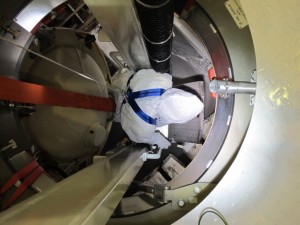
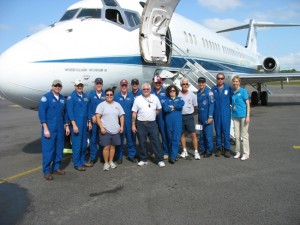

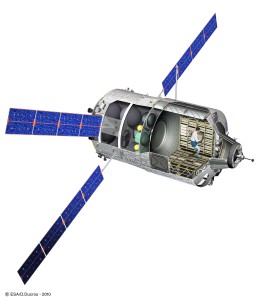
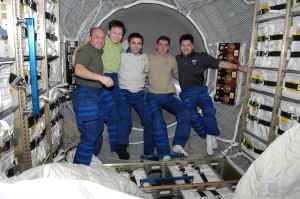
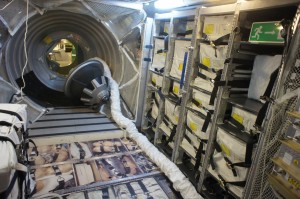
 Automated Transfer Vehicle page
Automated Transfer Vehicle page ATV blog archive
ATV blog archive
Discussion: no comments